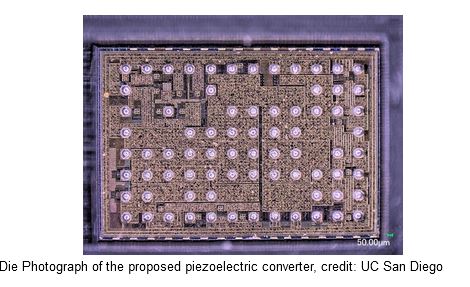UC San Diego and CEA-Leti's Breakthrough Piezoelectric Resonator DC-DC Converter
Date: 22/02/2024
In a groundbreaking collaboration between the University of California San Diego and CEA-Leti, scientists have unveiled a pioneering piezoelectric-based DC-DC converter, consolidating all power switches onto a single chip to enhance power density. This innovative power topology, showcased at ISSCC 2024, amalgamates the strengths of piezoelectric converters with capacitive-based DC-DC converters, heralding a new era in power conversion technology.

Unprecedented Efficiency: The Dual-side Series/Parallel Piezoelectric Resonator (DSPPR) represents the inaugural IC for piezoelectric resonator (PR)-based power conversion, achieving an astounding 310% reduction in losses compared to prior-art designs.
These power converters defy convention by offering significantly smaller form factors compared to conventional bulky inductors, paving the way for their integration into a myriad of devices ranging from smartphones to server farms and AR/VR headsets.
With the potential to be applied in various DC-DC conversion scenarios, the versatility of these converters holds promise for revolutionizing power management across diverse technological domains.
Paper Presentation: The research findings were presented in the paper titled "An Integrated Dual-side Series/Parallel Piezoelectric Resonator-based 20-to-2.2V DC-DC Converter Achieving a 310% Loss Reduction" at ISSCC 2024 in San Francisco, underscoring the significance of this breakthrough in the field of power electronics.
The advent of the Dual-side Series/Parallel Piezoelectric Resonator (DSPPR) represents a paradigm shift in power conversion technology, offering unparalleled efficiency and miniaturization. By transcending traditional limitations and leveraging the synergies between piezoelectric and capacitive-based approaches, this innovative DC-DC converter holds immense potential for reshaping the landscape of power management across a spectrum of applications. As the industry embraces this transformative leap, the collaborative efforts of UC San Diego and CEA-Leti stand as a testament to the power of innovation in driving progress forward.
“The Dual-side Series/Parallel Piezoelectric Resonator (DSPPR) is the first IC used for PR-based power conversion, and achieves up to 310% loss reduction over prior-art published and co-designed discrete designs for VCRs<0.125,” the paper reports.
The paper explains that a hybrid DSPPR converter exploits integrated circuits’ ability to offer sophisticated power stages in a small area compared to discrete designs, and enables efficient device operation at voltage conversion ratios (VCR) of less than 0.1.
In addition, incorporating additional capacitive-based converter stages, both pre- and post- the piezoelectric DC-DC converter, contributes to performance improvement.
“The IC provides a distinct opportunity to consolidate all power switches onto a single chip, significantly diminishing the PCB footprint and enhancing phase-control precision,” said Gael Pillonnet, scientific director of CEA-Leti’s Silicon Component Division.
“This strategic integration reduces the demand on piezoelectric material, resulting in a more compact converter with a notably smaller total volume. The marginal increase in additional capacitors, which is less than 10 percent, pales in comparison to the substantial gains facilitated by the proposed topology,” Pillonnet said.
“The DC-DC converter, particularly in the low VCR range, which was a focus of our work, has widespread applications in various sectors, such as high-power computing servers, automotive systems, USB chargers, and battery-powered devices,” said Wen-Chin Brian Liu, a Ph.D. student in Mercier’s research group and the lead author of the paper.
“This innovative approach enhances performance, especially at low voltage conversion ratios—an area where prior works struggled to sustain both high efficiency and optimal utilization of piezoelectric materials,” said Patrick Mercier, a professor in the Department of Electrical and Computer Engineering at UC San Diego and a senior author of the paper.


